
Golden West Airlines
TIMETABLES
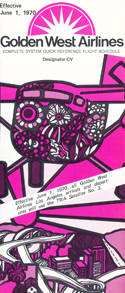 June
1970
June
1970
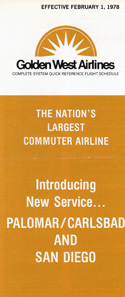 February 1978
February 1978
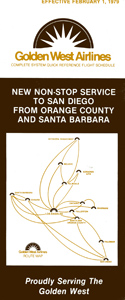 February
1979
February
1979
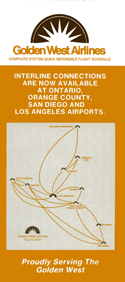 November
1979
November
1979
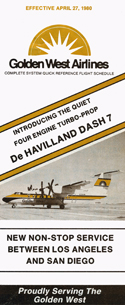 April
1980
April
1980
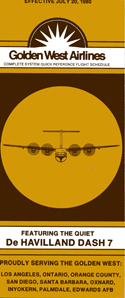 July
1980
July
1980
 October
1980
October
1980
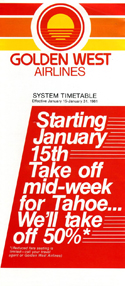 January
1981
January
1981
 January
1981 #2
January
1981 #2
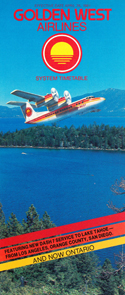 April
1981
April
1981
 July
1981
July
1981
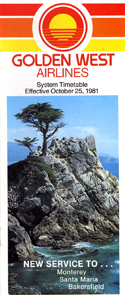 October
1981
October
1981
 December
1981
December
1981
 February
1982
February
1982
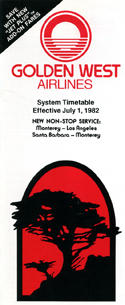 July
1982
July
1982
 October
1982
October
1982
 March
1983
March
1983
During the 1960s numerous local air carriers were started in an effort to promote “air-taxi” service to smaller communities nationwide. One state that was inundated with the start-up of these small local service carriers was California. With the major urban centers of Los Angeles and San Francisco, the use of small commuter type airlines was necessary to bridge the gap of smaller, remote communities with the larger metropolitan areas. As the number of start-up airlines increased, so did the number of ultimate failures and for the few left remaining the best way to starve of the competition was to consolidate and merge, and for a few choice airlines, the resultant product would be one of the largest commuter airlines in the United States; Golden West Airlines.
Golden West Airlines was the result of the
merger of four smaller local commuter airlines in California: Aero
Commuter, Cable Commuter, Skymark Airlines, and Golden West Airlines.
Aero Commuter Airlines: Aero Commuter was established at Long Beach in December of 1967 after taking over the operating certificate of defunct Catalina Air Lines which itself was established in August 1953 as Avalon Air Transport then renamed in 1963, to Catalina Air Lines. The airline operated a small fleet of nine-passenger Grumman Goose aircraft which operated on services from Long Beach to Avalon Bay at Catalina Island just off the coast of Southern California. Due to financial difficulties Catalina Air Lines ceased operations and was purchased by a new local air service carrier established at Long Beach known as Aero Commuter in December of 1967. Aero Commuter although taking the routes and aircraft (Goose and DHC-6 Twin Otters) from Catalina Air Lines, wanted to build a route system throughout Southern California and leased additional de Havilland DHC-6 Twin Otters and quickly started service from Long Beach Airport to Los Angeles International Airport, Burbank and Fullerton. Within a year, Aero Commuter had grown to be a strong commuter carrier in the Southern California region, adding additional cities to its route map including San Diego, Palm Springs, Palmdale, Oceanside, Santa Ana, Ontario, and Apple Valley. Service to Catalina Island remained and Aero Commuter decided to continue to market its Catalina flights under the old Catalina Airways name due to the positive recognition and niche market appeal. Service continued to the traditional Avalon Bay “amphibian” stop as well as the introduction of flights to Two Harbors and Airport-in-the-Sky both additional destinations on Catalina Island.
Cable Commuter: Cable Commuter was established on November 1, 1967 by Roger Cable whose vision was to connect the growing Inland Empire area of Southern California with Los Angeles and neighboring cities. Based at Ontario Airport, early flights used Beech 18 and Cessna 402 aircraft, until the airline placed a rather substantial order for twelve new de Havilland DHC-6 Twin Otter aircraft. The early flights connected Ontario, Palmdale/Lancaster, and Inyokern/China Lake with Los Angeles International Airport. As new aircraft were added, so were new cities and routes including Santa Ana, Palm Springs, Lake Havasu, Colton, and north along the coast to Ventura, Santa Barbara, and Santa Maria. By late 1968, Cable Commuter was operating fourteen DHC-6 Twin Otters, flying over 1600 flights a week and had become one of the largest commuters operating in the United States.
Golden West Airlines:
The “first” Golden West Airlines was established
December 1967 from Van Nuys Airport to fly commuter services initially
from Los Angeles International Airport to Santa Ana and Palomar/Carlsbad
using a de Havilland DHC-6 Twin Otter and the rather unusual German made
Hansa Jet. By December 1968, Golden West had grown considerably, adding
Riverside, Pomona, Redlands and Oxnard/Ventura to its network of flights
into Los Angeles. Within a few months however the airline started to
suffer financially and would terminate operations in March 1969.
Skymark Airlines: Northern California commuter airline Skymark Airlines started service on December 12, 1967, from a base at Sacramento to provide flights to both Oakland and Fresno using a fleet of Cessna 402, Piper Aztec’s, Beech 99’s and the de Havilland DHC-6 Twin Otter. During 1968 the airline quickly grew and added the cities on Bakersfield, Lake Tahoe, Truckee, Reno, San Francisco, San Jose and Monterey to its route network. Flying hundreds of flights a week, Skymark with a few years had established itself as a reliable commuter airline for northern California shuttling passengers from across the northern and central portions of California into the San Francisco Bay area.
Seeing an opportunity for a large, combined commuter airline in California, San Diego financier, C. Arnholt Smith purchased the assets of Cable Commuter, Skymark Airlines and Aero Commuter and consolidated the three carriers into one to be known collectively as Aero Commuter in March of 1969. During that same month, the “new” Aero Commuter purchased the operating certificate, routes, and aircraft of the recently defunct Van Nuys based Golden West, which had ceased services a few weeks earlier. This new mega commuter became known collectively as Golden West Airlines in May 1969, taking the name of the earlier carrier realizing the name reflected the true spirit of the services being provided in California. At the time of the merger, the route structure stretched from San Diego in the south, north to Sacramento and Santa Rosa and east to Palm Springs. The workhorse of the fleet would be the de Havilland DHC-6 Twin Otter of which thirty-five were acquired, with a few Beech 99’s remaining and the Grumman Goose of Catalina Airways, now a subsidiary of the new Golden West Airlines. A new color scheme was adopted consisting of a red and gold stripe with bold red font and early promotional literature purporting Golden West as the “Largest commuter airline in the world."
Within a year, the resultant merger of similar yet competing route networks and acquisition of such a large operating profile quickly lead Golden West into financial difficulties and by 1971 the airline was in debt $14 million dollars. One way to trim costs was to reduce or even eliminate cities that had become unprofitable and many cities were removed from the route map. What remained were the popular and profitable routes and cities including the LAX-Ontario, LAX-Santa Ana/Orange County and Ontario-Palm Springs routes. The fleet was consolidated to keep only the minimum number of aircraft necessary for scheduled services (Twelve Twin Otters). Even with the financial hardships, the airline took a risky venture by purchasing the operating certificate of the defunct helicopter airline Los Angeles Airways in 1971. LA Airways was a local “airline” that utilized helicopters for more convenient commuter services to the urban heliports across southern California. Golden West hoped to continue this niche market and acquired a Sikorsky S-61 and painted it in full Golden West colors. Flights were started from LAX to Anaheim where Disneyland was located and catering to that unique tourist market. Continued financial difficulties and lack of passengers lead Golden West to cease helicopter service about a year later.
The tourist market to Catalina Island continued to be the one venture by the company that was successful. The airline continued to operate Catalina Airways as a subsidiary and utilized the Grumman Goose Amphibians on services from Long Beach and Santa Ana to Avalon Bay and from Long Beach to Two-Harbors. Twin Otters were used to provide services from Long Beach and Los Angeles to Airport-in-the-Sky, located on the island. By 1972, thirty daily flights were connecting Catalina Island with the mainland.
As the early 1970s continued, Golden West scaled its operations considerably and sold off the original Skymark Airlines routes to STOL Air Commuter in San Francisco. Routes in Southern California were confined to the popular routes into Los Angeles International Airport (LAX) and continued services from the outlying areas such as Inyokern, and Santa Barbara using the Twin Otter on all services.
By the mid-1970s Golden West had established itself as a reputable commuter in Southern California especially in the busy Santa Ana-LAX and Ontario-LAX market. Golden West was able to form connecting airline agreements with virtually all the airlines operating from LAX, both domestic and international carriers. This allowed a passenger traveling from anywhere Golden West flew, one ticket and a seamless connection for both passenger and their baggage at LAX to a connecting flight either domestic or worldwide. These agreements solidified Golden West’s capability to operate with the major carriers, yet continue the customer service tradition of a local service carrier.
Tragedy struck Golden West Airlines on January 9, 1975, when a DHC-6-100 Twin Otter collided in mid-air with a private Cessna 150 over Whittier, California. Flight 261 was operating from Ontario Airport to Los Angeles International Airport when both aircraft collided at 2,200 feet. All 10 passengers and 2 crew aboard the Twin Otter, N6383 and 2 persons in the Cessna perished in the crash. This accident increased the awareness of the numerous private aircraft operating with local schedule air carriers in the always busy Los Angeles metropolitan airspace.
With the accident, 1975 was looking bleak. To further affect the airline was the economic and political disputes that owner C, Arnholt Smith was creating with his various corporate holdings and investigations undertaken by the California Public Utilities Commission, Civil Aeronautics Board and eventually Federal Security and Exchange Commission. Mr. Smith was required to divest himself from Golden West and the airline was sold to Hollis P. Roberts in 1976.
A more positive note came to Golden West in March of 1977 when the first of two ordered Shorts Brothers SH-330 aircraft arrived for service. The Shorts were acquired for numerous reasons; first, the passenger capacity of the Shorts was thirty compared to the Twin Otters eighteen. This was necessary for those major markets, including the Santa Ana-LAX and Ontario-LAX routes. The Shorts 330 was also marketed for the “airline” feel as the “wide-bodied” cabin actually had a center aisle and needed a flight attendant, a first for Golden West Airlines. The range and cabin comfort of the new Shorts allowed Golden West to compete with larger airlines using jets (United 737, Hughes Airwest DC-9) on services to cities such as Santa Barbara. Although the airline looked at other turboprop options including the Hawker-Siddley HS-748, the Shorts utilized the same Pratt and Whitney PT-6 turboprop as was used in its Twin Otters. This commonality made it a rather lucrative selling point, especially from a maintenance perspective. Along with the new aircraft, Golden West introduced a new color scheme, replacing the older red and gold stripes with an “earthy” tone of brown and yellow stripes.
During 1977, Golden West added new service to Palomar (Carlsbad) and San Diego as well as flights to Oxnard, midway between Los Angeles and Santa Barbara. Contract mail was still being carried by the airline along with passengers on the route to Inyokern/Ridgecrest and Mojave, both small communities in the northern Mojave Desert region. Another unique destination Golden West flew to was Edwards Air Force Base when flights were started in November 1978. Edwards was instrumental in the development of numerous Air Force test flight programs as well as the Space Shuttle testing and workers were carried from both the Los Angeles basin and Palmdale into the sprawling desert base.
Golden West entered the 1980s as relatively strong commuter with a great deal of its financial woes in the past. Due to increased passenger demand and looking to the future of longer flights, Golden west ordered and put into service the De Havilland Canada Dash-7 commuter. This new four-engined turboprop was marketed as a major addition to the Golden West fleet. With fifty seats, the new Dash-7’s were used on the heavy routes connecting into LAX. A total of four DHC-7 were purchased at a cost of $26 million and delivered in 1980, the first arriving in March of that year. In the fall of 1980, Golden West embarked upon a new corporate image, which included the presentation of a new logo consisting of the warm colors of a setting California sun, along with a new logo showing a stylized sun sinking into the Pacific horizon.
With the additions of the DHC-7s the airline undertook a major expansion program in 1981, including the inauguration of services to Lake Tahoe, California. Lake Tahoe was a tourist destination in the central Sierra Mountains and local regulations restricted jet service into the 7,000-foot high airport. Golden West used the new DHC-7s and started non-stop services from LAX, Orange County (Santa Ana) and San Diego to Lake Tahoe Airport. Aside from Lake Tahoe, the airline continued to look northward and by October of 1981 added the cities of Monterey, Santa Maria, San Francisco, Fresno, and Bakersfield to its network.
Throughout 1982, the airline continued to add
flights and routes to its network and by the end of 1982 had 123 daily
flights in its California market and had grown to become the third
largest commuter in the United States flying a fleet of six DHC-7s, five
Shorts SH-330, and five DHC-6 Twin otters.
Golden West had even placed a firm option to purchase three of
the new De Havilland Canada DHC-8 turboprops to replace the SH-330
aircraft.
Rumors were also abound that
had the airline looking at possible purchase of the new British
Aerospace BAe 146 to better compete on popular routes to the Bay area
from Los Angeles.
Starting in 1983, Golden West had turned the corner internally from a thriving, growing regional carrier to one in dire financial straits. The purchase of the original DHC-7 aircraft in 1981 started a spiraling financial problem the airline fought hard to control. The departure of airline President, Henry Voss in 1982 compounded the problem and before the arrival of new President John Harper, Golden West was having trouble meeting its payroll requirements. There was the possibility of a minority purchase by Pan American Airlines for $3 million to help get the carrier out of its mounting debt. This deal fell through and the airline continued to struggle until Friday, April 22, 1983 when the carrier was forced to shut down and layoff all 400 employees. Although there were plans to file Chapter 11 bankruptcy protection to allow for reorganization, this failed and the airline ceased operations, setting the sun on a carrier which had brought together the outlaying airports of Southern California and brought a ray of golden light to the millions of passengers making their convenient connections into LAX.
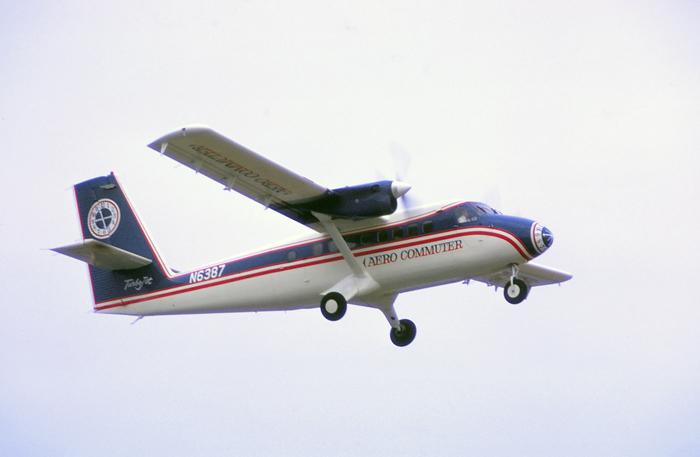 The versatile de
Havilland DHC-6 Twin Otter was well suited for the "commuter"
routes across Southern California started by Aero Commuter after its
purchase of Catalina Airlines. Wearing its attractive color scheme,
N6387, a de Havilland Canada DHC-6-100 is seen on an overcast day in June in
1968.
The versatile de
Havilland DHC-6 Twin Otter was well suited for the "commuter"
routes across Southern California started by Aero Commuter after its
purchase of Catalina Airlines. Wearing its attractive color scheme,
N6387, a de Havilland Canada DHC-6-100 is seen on an overcast day in June in
1968.
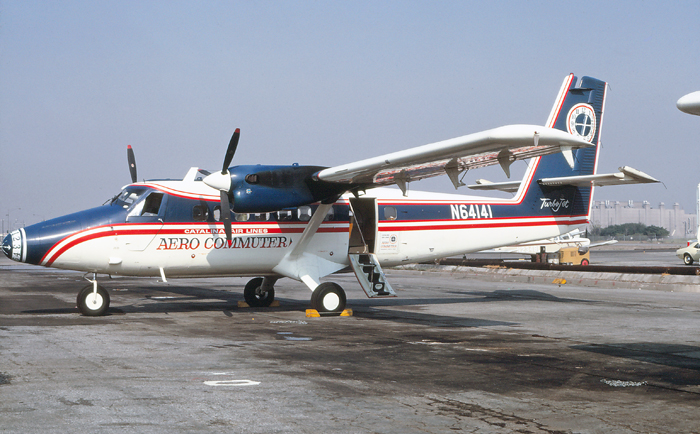 After the purchase
of Catalina Air Lines, Aero Commuter introduced a new color scheme
however still applied titles of its former owner to remind passengers
that Catalina services would continue. Parked on the ramp at Long Beach
Airport in November 1968, is N64141, a de Havilland Canada DHC-6-200.
After the purchase
of Catalina Air Lines, Aero Commuter introduced a new color scheme
however still applied titles of its former owner to remind passengers
that Catalina services would continue. Parked on the ramp at Long Beach
Airport in November 1968, is N64141, a de Havilland Canada DHC-6-200.
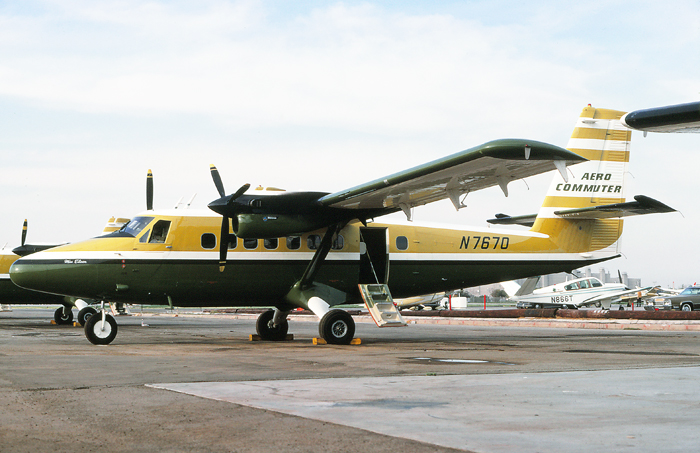 During the initial
merger of Aero Commuter, Cable Commuter, and Skymark Airlines, Aero
Commuter assumed operation of a Cable Commuter Twin Otter and quickly
applied its titles. Parked on the ramp at Long Beach Airport in April
1969, and wearing hybrid colors, is N7670 "Miss Eileen," a de
Havilland Canada DHC-6-200.
During the initial
merger of Aero Commuter, Cable Commuter, and Skymark Airlines, Aero
Commuter assumed operation of a Cable Commuter Twin Otter and quickly
applied its titles. Parked on the ramp at Long Beach Airport in April
1969, and wearing hybrid colors, is N7670 "Miss Eileen," a de
Havilland Canada DHC-6-200.
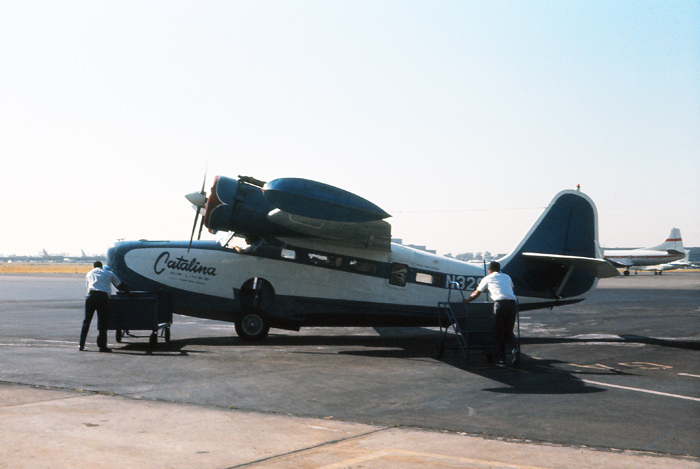 The amphibious
Grumman Goose were perfect aircraft for the daily jaunts to Catalina
Island, thirty miles offshore of Los Angeles. Having just arrived from
Catalina Island and awaiting unloading at Long Beach Airport in
September 1969, is N329, a Grumman G-21A Goose.
The amphibious
Grumman Goose were perfect aircraft for the daily jaunts to Catalina
Island, thirty miles offshore of Los Angeles. Having just arrived from
Catalina Island and awaiting unloading at Long Beach Airport in
September 1969, is N329, a Grumman G-21A Goose.
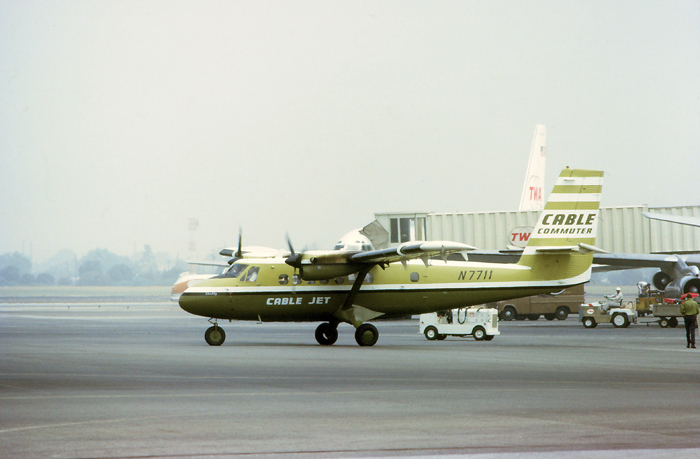 Cable Commuter
shuttled passengers into Los Angeles International Airport with over
sixty daily departures and promoting turboprop service with "Cable
Jet" titles. Seen taxiing outbound for takeoff at Los Angeles
International Airport in May 1968, is N7711 "Shelley," a de
Havilland Canada DHC-6-100.
Cable Commuter
shuttled passengers into Los Angeles International Airport with over
sixty daily departures and promoting turboprop service with "Cable
Jet" titles. Seen taxiing outbound for takeoff at Los Angeles
International Airport in May 1968, is N7711 "Shelley," a de
Havilland Canada DHC-6-100.
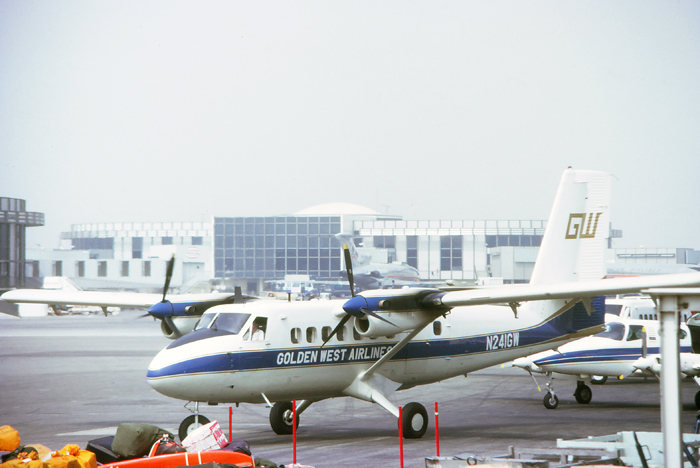 Based at Van Nuys,
California, the original Golden West Airlines also utilized the DHC-6
Twin Otter for commuter services across Southern California, such as
this example, N241GW, a de Havilland Canada DHC-6-100, at Los Angeles
International Airport in May 1968.
Based at Van Nuys,
California, the original Golden West Airlines also utilized the DHC-6
Twin Otter for commuter services across Southern California, such as
this example, N241GW, a de Havilland Canada DHC-6-100, at Los Angeles
International Airport in May 1968.
 In late 1968,
Golden West Airlines expanded operations to serve smaller satellite
airports in the "Inland Empire" region of Southern California to shuttle
passengers into connecting flights at Los Angeles International Airport.
Parked on the ramp at Pomona Airport (Brackett Field) and awaiting
passengers on an overcast morning in March 1969, is N241GW, a de
Havilland Canada DHC-6-100.
In late 1968,
Golden West Airlines expanded operations to serve smaller satellite
airports in the "Inland Empire" region of Southern California to shuttle
passengers into connecting flights at Los Angeles International Airport.
Parked on the ramp at Pomona Airport (Brackett Field) and awaiting
passengers on an overcast morning in March 1969, is N241GW, a de
Havilland Canada DHC-6-100.
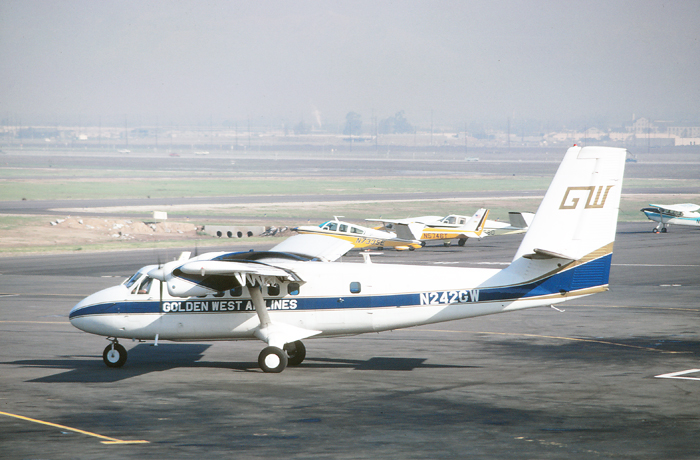 Golden West
Airlines had signed a code-sharing agreement with Continental Airlines
at Los Angeles International Airport to feed passengers into connecting
flights. Santa Ana-Orange County saw over thirteen flights daily to LAX,
such as this example N242GW a de Havilland Canada DHC-6-100 departing
the ramp area in March 1969.
Golden West
Airlines had signed a code-sharing agreement with Continental Airlines
at Los Angeles International Airport to feed passengers into connecting
flights. Santa Ana-Orange County saw over thirteen flights daily to LAX,
such as this example N242GW a de Havilland Canada DHC-6-100 departing
the ramp area in March 1969.
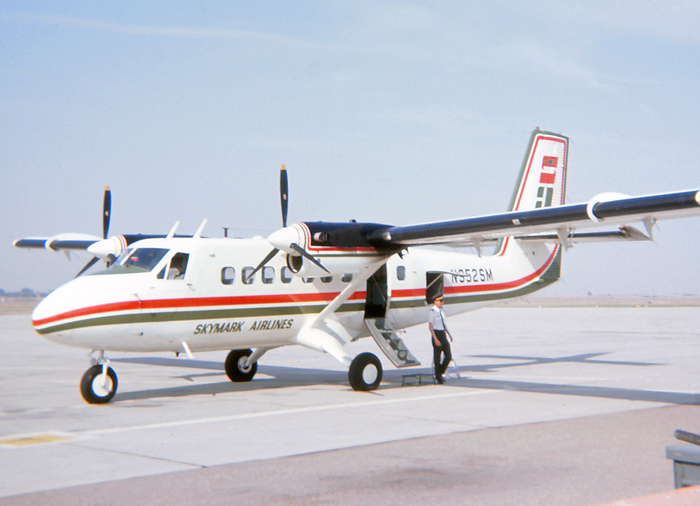 Started to provide
feeder flights from Northern and Central California cities into both San
Francisco and Sacramento, Skymark Airlines used a small fleet of Beech
99s and Twin Otters, such as this new de Havilland Canada DHC-6-100, N952SM,
awaiting passengers at Sacramento Metropolitan Airport in April 1968.
Started to provide
feeder flights from Northern and Central California cities into both San
Francisco and Sacramento, Skymark Airlines used a small fleet of Beech
99s and Twin Otters, such as this new de Havilland Canada DHC-6-100, N952SM,
awaiting passengers at Sacramento Metropolitan Airport in April 1968.
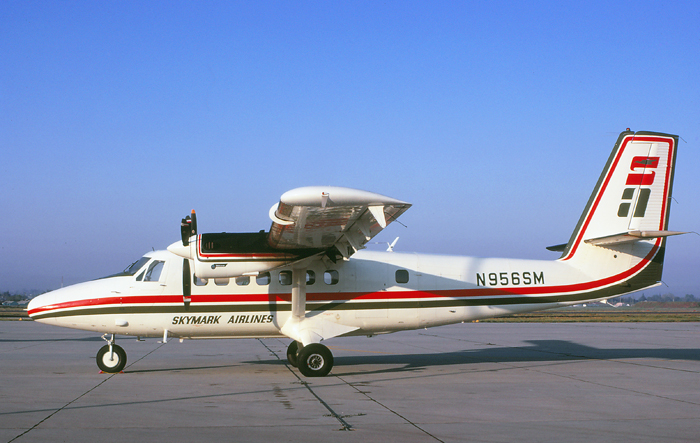 Although only in
operation for just over a year, Skymark Airlines had become a formidable
commuter in Northern California expanded to seven cities before being
purchased by Aero Commuter in 1969. Parked on the ramp at Fresno Air
Terminal in October 1969 and still wearing the original Skymark colors
is N956TM, a De Havilland Canada DHC-6-200.
Although only in
operation for just over a year, Skymark Airlines had become a formidable
commuter in Northern California expanded to seven cities before being
purchased by Aero Commuter in 1969. Parked on the ramp at Fresno Air
Terminal in October 1969 and still wearing the original Skymark colors
is N956TM, a De Havilland Canada DHC-6-200.
 Wearing the new
color scheme of the "new" Golden West Airlines, N63119, a de
Havilland Canada DHC-6-100 sits on the ramp and awaits passengers at Los
Angeles International Airport in October 1969.
Wearing the new
color scheme of the "new" Golden West Airlines, N63119, a de
Havilland Canada DHC-6-100 sits on the ramp and awaits passengers at Los
Angeles International Airport in October 1969.
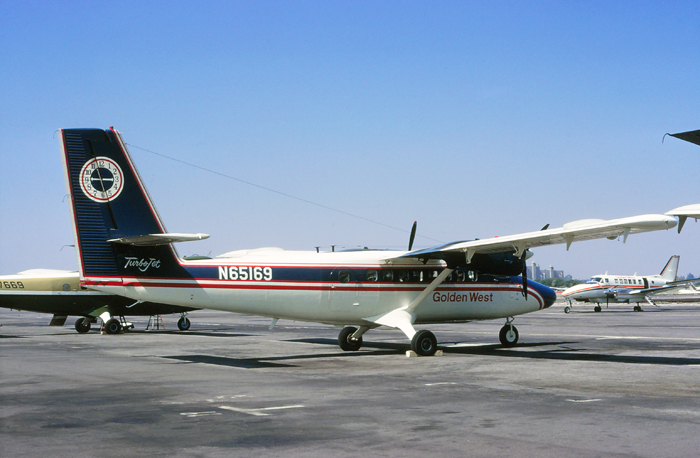 Still wearing the
colors of previous operator Aero Commuter yet with new "Golden West"
titles applied is N65169, a de Havilland Canada DHC-6-200 seen at Long
Beach Airport in December 1969.
Still wearing the
colors of previous operator Aero Commuter yet with new "Golden West"
titles applied is N65169, a de Havilland Canada DHC-6-200 seen at Long
Beach Airport in December 1969.
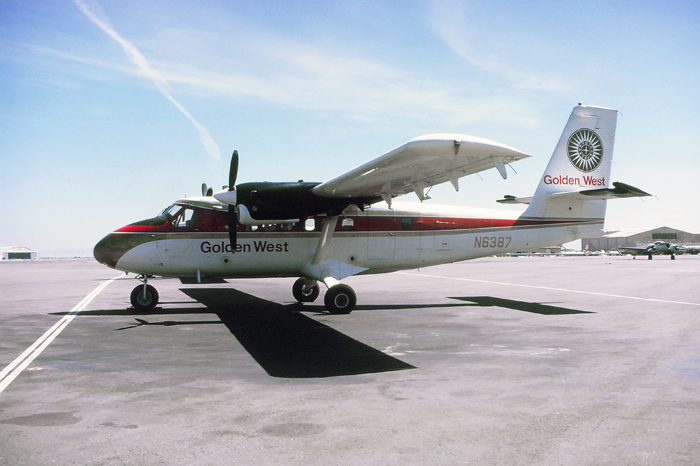 Golden West
continued to operate the ex Skymark Airlines routes in Northern
California until 1974 when the routes were sold of to STOL Air Commuter.
Parked on the ramp at San Francisco International Airport in September
1970, is N6387, a de Havilland Canada DHC-6-100 originally delivered new
to Aero Commuter.
Golden West
continued to operate the ex Skymark Airlines routes in Northern
California until 1974 when the routes were sold of to STOL Air Commuter.
Parked on the ramp at San Francisco International Airport in September
1970, is N6387, a de Havilland Canada DHC-6-100 originally delivered new
to Aero Commuter.
 Skymark Airlines
used two Beech 99 turboprops in addition to its Twin otters on Northern
California commuter flights. After the mergers Golden West continued to
operate the Beech 99s until 1972 when they were sold off. Parked on the
ramp at San Francisco International Airport in September 1981, is N9991
a Beech XX.
Skymark Airlines
used two Beech 99 turboprops in addition to its Twin otters on Northern
California commuter flights. After the mergers Golden West continued to
operate the Beech 99s until 1972 when they were sold off. Parked on the
ramp at San Francisco International Airport in September 1981, is N9991
a Beech XX.
 Golden West
Airlines continued to operate the predecessor Catalina Air Lines routes
using both the amphibious Goose and Twin Otter to Avalon, Two-Harbors,
and Airport-in-the-Sky on Catalina Island. Parked on the ramp at Long
Beach Airport and awaiting passengers in June 1972, is N1133, a Grumman
G-21A Goose.
Golden West
Airlines continued to operate the predecessor Catalina Air Lines routes
using both the amphibious Goose and Twin Otter to Avalon, Two-Harbors,
and Airport-in-the-Sky on Catalina Island. Parked on the ramp at Long
Beach Airport and awaiting passengers in June 1972, is N1133, a Grumman
G-21A Goose.
 In 1972 the Civil
Aeronautics Board (CAB) allowed commuter carriers to start operating
aircraft with up to the thirty seats which helped in many busy markets.
Golden West placed an order for the Belfast, Northern Ireland made
Shorts 330. Seen at Paris-Orly International Airport enroute to the June
1977 Paris Air Show for display is G-BDMA, a Shorts SD-330-100 wearing
the original Golden West colors but subsequently not delivered in this
scheme a year later.
In 1972 the Civil
Aeronautics Board (CAB) allowed commuter carriers to start operating
aircraft with up to the thirty seats which helped in many busy markets.
Golden West placed an order for the Belfast, Northern Ireland made
Shorts 330. Seen at Paris-Orly International Airport enroute to the June
1977 Paris Air Show for display is G-BDMA, a Shorts SD-330-100 wearing
the original Golden West colors but subsequently not delivered in this
scheme a year later.
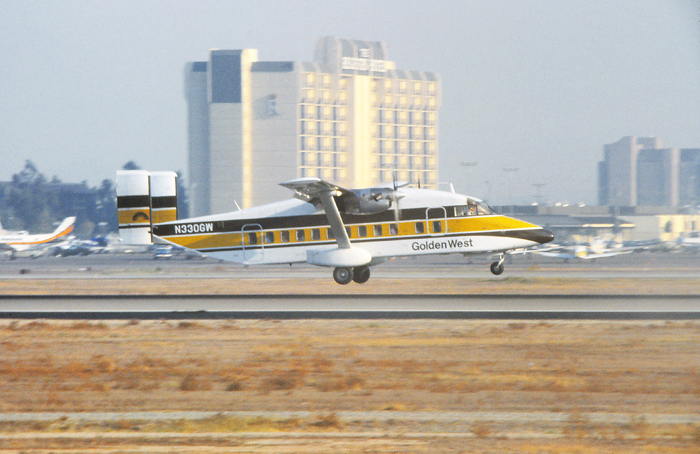 When Golden West
received their first Shorts SH-330 the airline introduced a new
"Earth Tone" color scheme as seen on N330GW, a Shorts SD-330-100
about to touch down on Runway 19 Right at Santa Ana-Orange County
Airport in March 1978.
When Golden West
received their first Shorts SH-330 the airline introduced a new
"Earth Tone" color scheme as seen on N330GW, a Shorts SD-330-100
about to touch down on Runway 19 Right at Santa Ana-Orange County
Airport in March 1978.
 The new
thirty-passenger Shorts had "wide-body" seating and a flight
attendant and was initially used by Golden West Airlines on busy trunk
routes into LAX. Seen parked on the commuter ramp at Los Angeles
International Airport in April 1978, is N330GW, a Shorts SD-330-100.
The new
thirty-passenger Shorts had "wide-body" seating and a flight
attendant and was initially used by Golden West Airlines on busy trunk
routes into LAX. Seen parked on the commuter ramp at Los Angeles
International Airport in April 1978, is N330GW, a Shorts SD-330-100.
 Wearing the
updated colors and preparing to start-up for an evening departure at
Santa Ana-Orange County Airport in October 1978, is N63118, a de
Havilland Canada DHC-6-100 Twin Otter.
Wearing the
updated colors and preparing to start-up for an evening departure at
Santa Ana-Orange County Airport in October 1978, is N63118, a de
Havilland Canada DHC-6-100 Twin Otter.
 In the fall of
1980, Golden West Airlines introduced a new corporate color scheme of
the setting California sun with "warm" orange and red
cheat-lines as displayed on the newly painted de Havilland Canada
DHC-6-200, parked on the commuter ramp at Los Angeles International
Airport in October 1980.
In the fall of
1980, Golden West Airlines introduced a new corporate color scheme of
the setting California sun with "warm" orange and red
cheat-lines as displayed on the newly painted de Havilland Canada
DHC-6-200, parked on the commuter ramp at Los Angeles International
Airport in October 1980.
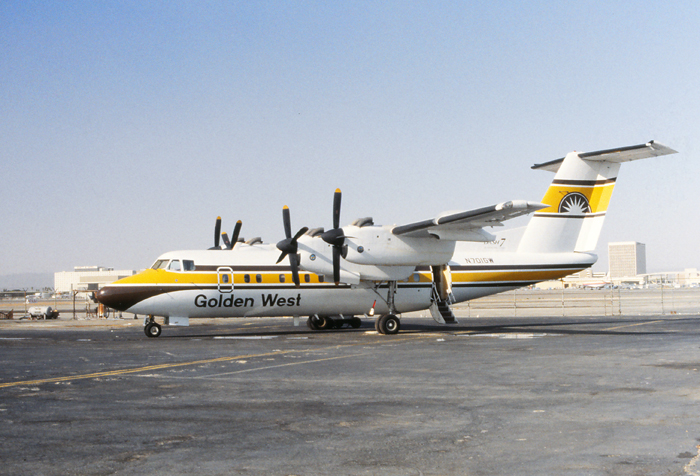 In the post
deregulation era, passenger numbers continued to increase so much so
that Golden West Airlines placed an order for seven of the
fifty-passenger de Havilland DHC-7 "Dash 7" aircraft for use on
the popular trunk routes. Seen parked at the airlines maintenance hanger
at Los Angeles International Airport in October 1980 is N701GW, a de
Havilland Canada DHC-7-102.
In the post
deregulation era, passenger numbers continued to increase so much so
that Golden West Airlines placed an order for seven of the
fifty-passenger de Havilland DHC-7 "Dash 7" aircraft for use on
the popular trunk routes. Seen parked at the airlines maintenance hanger
at Los Angeles International Airport in October 1980 is N701GW, a de
Havilland Canada DHC-7-102.
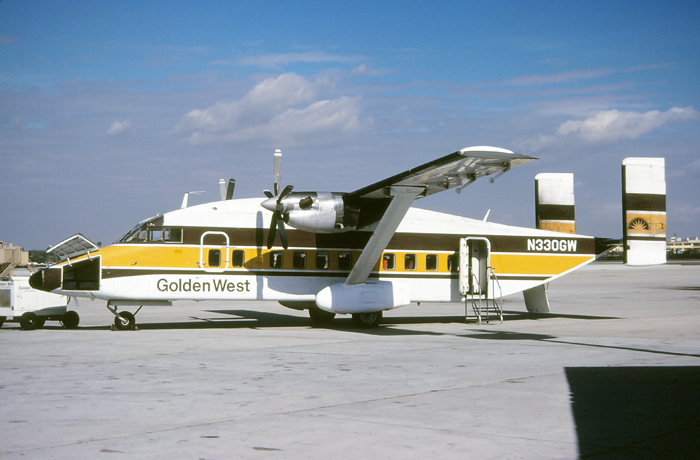 San
Diego had originally been serviced by Aero Commuter in 1969 for a few
months and the new Golden West chose not to continue the service. In
December 1977, San Diego was added to the route map again with flights
to Santa Barbara, Oxnard, and Palomar. On the ramp preparing for a
morning departure at San Diego-Lindbergh Field in March 1981, is N330GW,
a Shorts SD-330-100.
San
Diego had originally been serviced by Aero Commuter in 1969 for a few
months and the new Golden West chose not to continue the service. In
December 1977, San Diego was added to the route map again with flights
to Santa Barbara, Oxnard, and Palomar. On the ramp preparing for a
morning departure at San Diego-Lindbergh Field in March 1981, is N330GW,
a Shorts SD-330-100.
 The
"Short-Takeoff-Or-Landing" (STOL) characteristics of the new Dash
7, allowed the airline to make runway intersection departures,
especially at airports such as LAX which saved taxi time and ultimately
flight times. Parked on the commuter ramp at Los Angeles International
Airport in July 1981, is N724GW a de Havilland Canada DHC-7-102.
The
"Short-Takeoff-Or-Landing" (STOL) characteristics of the new Dash
7, allowed the airline to make runway intersection departures,
especially at airports such as LAX which saved taxi time and ultimately
flight times. Parked on the commuter ramp at Los Angeles International
Airport in July 1981, is N724GW a de Havilland Canada DHC-7-102.
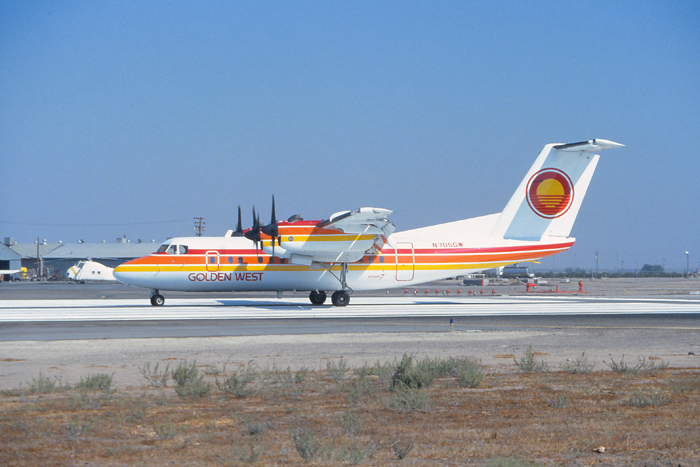 In July 1981,
Golden West Airlines expanded across Central and Northern California
starting service to Fresno from Los Angeles and Santa Ana-Orange County.
Seen holding in position for takeoff on Runway 29 Right at Fresno Air Terminal
in October 1981, is N705GW, a de Havilland DHC-7-102.
In July 1981,
Golden West Airlines expanded across Central and Northern California
starting service to Fresno from Los Angeles and Santa Ana-Orange County.
Seen holding in position for takeoff on Runway 29 Right at Fresno Air Terminal
in October 1981, is N705GW, a de Havilland DHC-7-102.
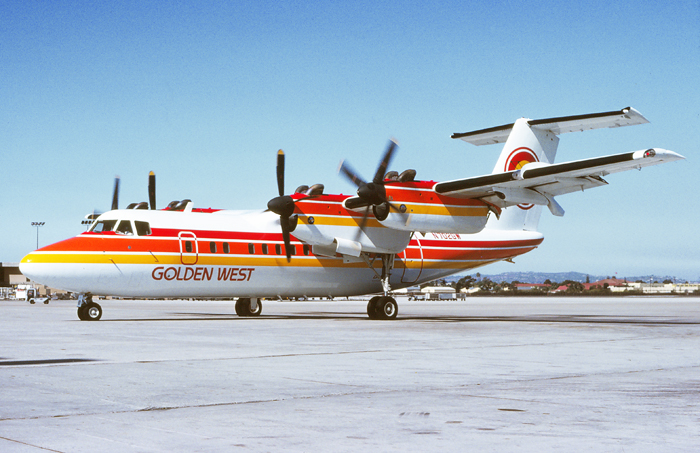 San Diego saw the
Dash 7s introduced in late 1980 on flights to Los Angeles and a year
later on non-stop services to Lake Tahoe. Seen with engines running and
awaiting taxi clearance away from the commuter ramp at San
Diego-Lindbergh Field in November 1981, is N702GW, a de Havilland Canada
DHC-7-102.
San Diego saw the
Dash 7s introduced in late 1980 on flights to Los Angeles and a year
later on non-stop services to Lake Tahoe. Seen with engines running and
awaiting taxi clearance away from the commuter ramp at San
Diego-Lindbergh Field in November 1981, is N702GW, a de Havilland Canada
DHC-7-102.
 San Francisco
was reintroduced to the network in July 1981 with flights to Fresno and
soon thereafter Monterey and Lake Tahoe and opening a new market in
Northern California. Seen taxiing along the inner apron at San Francisco
International Airport in December 1981, is N705GW, a de Havilland Canada
DHC-7-102.
San Francisco
was reintroduced to the network in July 1981 with flights to Fresno and
soon thereafter Monterey and Lake Tahoe and opening a new market in
Northern California. Seen taxiing along the inner apron at San Francisco
International Airport in December 1981, is N705GW, a de Havilland Canada
DHC-7-102.
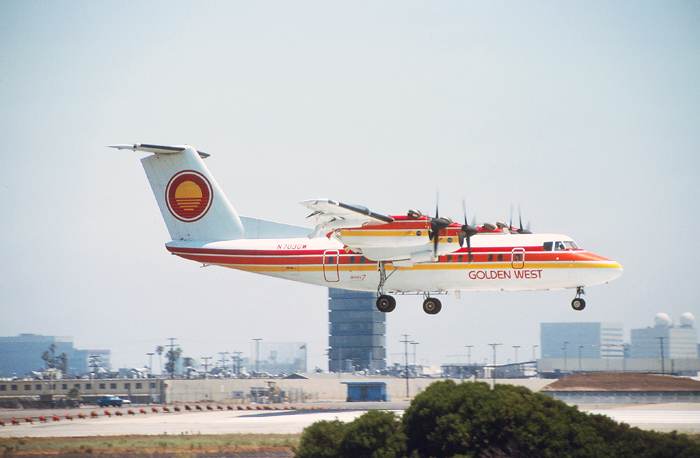 Seen over the
numbers for landing on Runway 24 Right at Los Angeles International
Airport in July 1982, is N703GW, a de Havilland Canada DHC-7-102.
Seen over the
numbers for landing on Runway 24 Right at Los Angeles International
Airport in July 1982, is N703GW, a de Havilland Canada DHC-7-102.
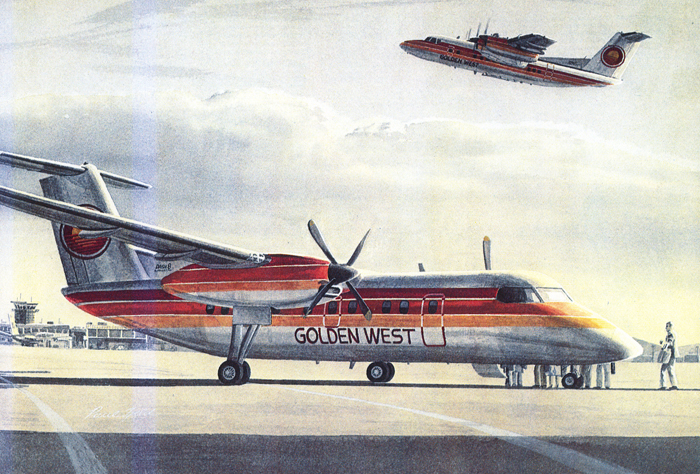 Golden West
Airlines placed an order for three of the new de Havilland DHC-8
aircraft in 1982 to replace the Shorts SD-330 and expand operations.
Although the aircraft were never delivered, this artists representation
looks sharp on what might have been.
Golden West
Airlines placed an order for three of the new de Havilland DHC-8
aircraft in 1982 to replace the Shorts SD-330 and expand operations.
Although the aircraft were never delivered, this artists representation
looks sharp on what might have been.
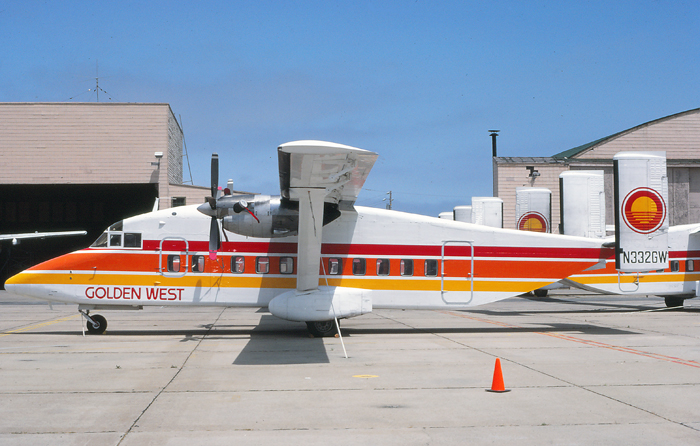 After the demise
of Golden West Airlines in April 1983, many of the aircraft were flown
to Monterey Regional Airport for storage pending disposition. Three
Shorts 330s are seen in storage at Monterey Regional Airport in June
1983, including N332GW, a Shorts SD-330-100.
After the demise
of Golden West Airlines in April 1983, many of the aircraft were flown
to Monterey Regional Airport for storage pending disposition. Three
Shorts 330s are seen in storage at Monterey Regional Airport in June
1983, including N332GW, a Shorts SD-330-100.